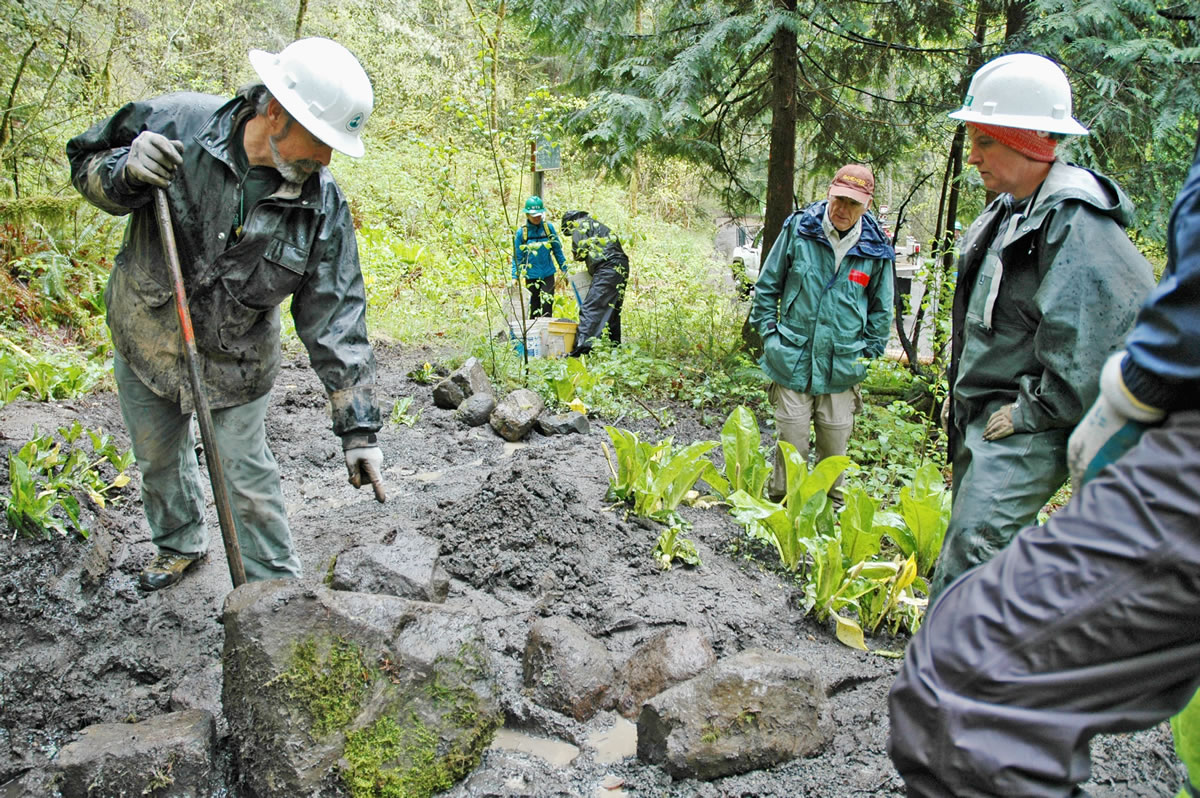CASCADE LOCKS, Ore. — Bill Hawley of Washougal started the field session of his class on water crossings at the Columbia Cascades Trail Skills College with an introduction of the tools and a safety chat.
Hawley picked up a six-tined rake, of sorts, called a “McLeod.”
Rule No. 1: Put the McLeod a safe distance away from when not using it.
“That’s six sucking chest wounds if you fall upon it,” Hawley explained to the 15 volunteers about to repair a wet area on Gorge trail No. 400 near Eagle Creek in the Columbia River Gorge National Scenic Area.
The trail school in late April here was a joint effort between the U.S. Forest Service, Pacific Crest Trail Association, Washington Trails Association and backcountry horsemen’s groups in both Washington and Oregon.
There were more than 200 attendees.
Sponsored by outdoor retailer REI, the three-day event taught skills including building rock walls, first-aid, deconstructing unwanted trails and Hawley’s offering on water crossings.
“Water runs down the landscape and it not only sheets across the surface it also sort of percs through,” said Hawley, a retired construction manager. “When we create a trail or road or any structure, we use it, and we compact it. That makes a dam for all the water that would typically run through the landscape. The water tends to come out on the surface. When we have water on the trail on this side of the state we have mud.”
There are many methods to get the water through the trail.
Hawley said as minimal a structure as possible is best. Rocks and logs generally are used.
“You use what’s available that you don’t have to move too far,” he said.
Culverts and plastic piping are a last resort.
“We try to get it as naturally self-draining as possible,” said Bruce Dungey of the Forest Service.
When culverts are used, the crossing is designed so hikers won’t see the metal, Dungey said.
“Wilderness or not, we still don’t want to see culverts on the trail,” he added.
Many of the participants at the trail skills college already do trail maintenance.
Hawley, an associate regional representative for the Pacific Crest Trail Association, is the PCTA’s Caretaker for the Crest trail between the Bridge of the Gods and Carpenters Lake, a distance of about seven miles.
He’s also Caretaker of the 9 1/4 miles from Crest Camp on Gifford Pinchot National Forest road No. 60 to Junction Lake in the heart of Indian Heaven Wilderness.
Chris Sanderson of Portland is the PCTA’s Caretaker from Carpenter Lake to Three Corner Rock, a distance of about eight miles.
Sanderson, 43, has completed the triple crown of long-distance hiking. He walked the Appalachian Trail in 2000, the Pacific Crest Trail in 2003 and the Continental Divide Trail in 2009.
“I’m here to learn more,” Sanderson said. “I’m not an expert. I maintain an eight-mile section and this makes me a better volunteer. This is the next step in my experience with the trail.”
Bob Arkes, 74, also of Portland, is Caretaker of a 13-mile stretch of the Crest trail in the Mount Adams Wilderness from Williams Mine trailhead on road No. 23 north of Trout Lake to the crossing of Riley Creek.
Arkes maintains a high-elevation stretch of the PCT, with a snowfree season only from mid- to late July until October. Still, he and his volunteers work five to six days annually.
When the Mount Hood chapter of the PCTA took on responsibility for the southern Washington end of the Crest trail, Arkes scouted the Mount Adams section and got attached to it.
It has been suggested he extend his caretakership all the way north to the Pacific Crest Trail crossing with Gifford Pinchot road No. 5603 near Potato Hills.
“I’m 74,” said Arkes, recipient of a hip replacement last week. “That would be too many miles.”




